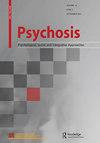Experience of psychosis during the COVID-19 pandemic among hospitalized patients
IF 1
4区 医学
Q4 PSYCHIATRY
Psychosis-Psychological Social and Integrative Approaches
Pub Date : 2022-01-06
DOI:10.1080/17522439.2021.2009548
引用次数: 1
Abstract
ABSTRACT Background The content of auditory hallucinations (AHs) and delusions is malleable and reflects the social environment and the local culture. COVID-19 is a significant new feature of the social environment, yet research has not yet determined how the phenomenology of psychosis has changed since the COVID-19 outbreak. Methods Adult patients (N = 17) receiving care within an acute inpatient psychiatric care setting in Boston were recruited to participate in an hour-long Zoom interview about their psychosis phenomenology and the potential impact of COVID-19. Results Thematic analysis of interview data found that for many, ideas about COVID-19 were present in the content of their AHs and shaped their paranoid ideation. Some felt that the frequency and loudness of the AHs had increased. However, not all participants spoke in ways that suggested the virus had affected their experience. Discussion Results demonstrate that COVID-19 influenced the content of psychosis for many, but the effect of COVID-19 on psychosis was not uniform. The increased social isolation, financial insecurity, and socio-political climate of the period also seemed to negatively impact individuals with psychosis. Understanding how COVID-19 specifically has influenced psychosis helps to illustrate how societal and external factors may shape this experience.新冠肺炎大流行期间住院患者的精神病体验
摘要背景幻听和妄想的内容具有可塑性,反映了社会环境和当地文化。新冠肺炎是社会环境的一个重要新特征,但研究尚未确定自新冠肺炎爆发以来精神病现象发生了怎样的变化。方法招募波士顿急性住院精神病治疗环境中接受治疗的成年患者(N=17)参加为期一小时的Zoom访谈,了解他们的精神病现象学和新冠肺炎的潜在影响。结果访谈数据的主题分析发现,对许多人来说,关于新冠肺炎的想法存在于他们的AHs内容中,并塑造了他们的偏执思维。一些人觉得AHs的频率和响度都增加了。然而,并非所有参与者的发言方式都表明病毒影响了他们的体验。讨论结果表明,新冠肺炎对精神病的含量有很大影响,但新冠肺炎对精神病影响并不一致。这一时期日益严重的社会孤立、经济不安全和社会政治气候似乎也对精神病患者产生了负面影响。了解新冠肺炎如何具体影响精神病,有助于说明社会和外部因素如何影响这种体验。
本文章由计算机程序翻译,如有差异,请以英文原文为准。
求助全文
约1分钟内获得全文
求助全文
来源期刊
CiteScore
2.20
自引率
8.30%
发文量
36

 求助内容:
求助内容: 应助结果提醒方式:
应助结果提醒方式:


